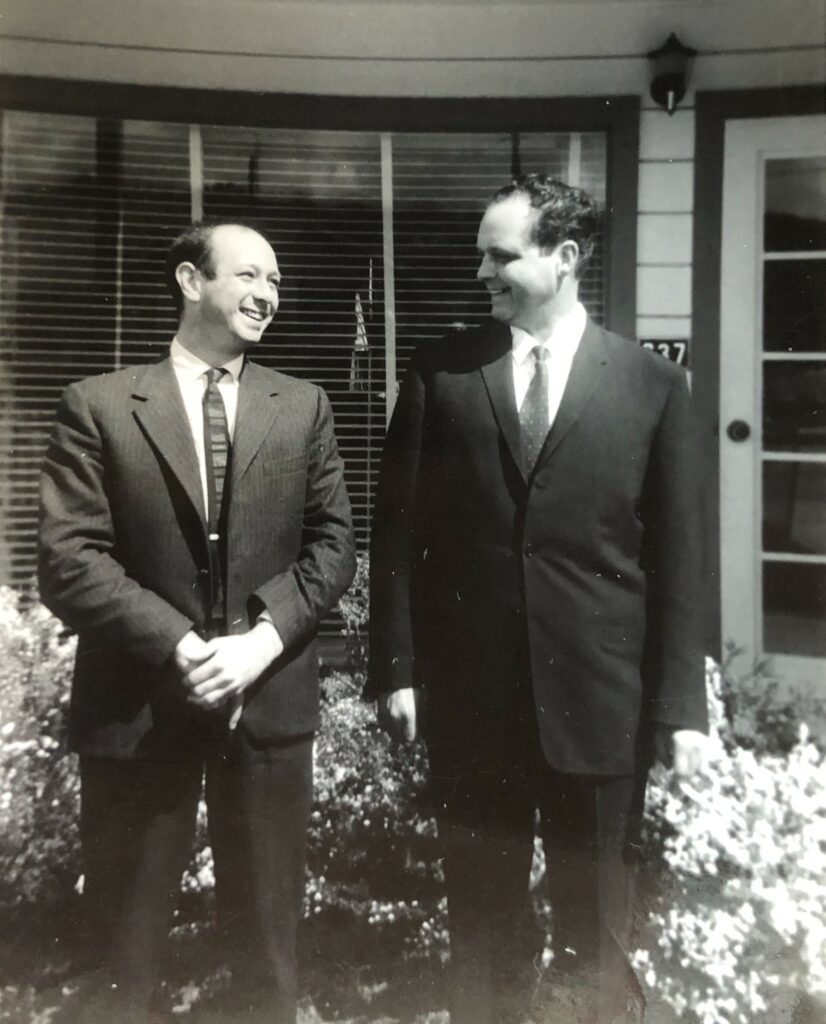
Robert Grove Hughes, was an American composer, conductor, bassoonist, publisher, and advocate for contemporary music. His compositions for western and eastern instruments, ballet and film were performed and recorded in the U.S. and abroad. He was 1977 composer-in-residence with San Francisco Symphony, and was commissioned by St. Paul Chamber Orchestra, San Francisco Ballet, and Oakland Symphony, among others. His film scores include Disney’s “Never Cry Wolf”. His last work Silenus’s Antiphonary is a hand-drawn synaesthetic compendium of music, poetry, and visual art.
Early studies with composer Lou Harrison led to their lifelong association. Hughes premiered, arranged, co-composed, conducted and recorded Harrison’s works from 1961. In 1963 they co-founded Cabrillo Music Festival (Aptos CA). Carlos Chavez, their third Music Director, commissioned Hughes to compose four orchestral works with electronics.
In 1964 Hughes founded Youth Chamber Orchestra (YCO) for Gerhard Samuel at Oakland Symphony. Under Hughes’ leadership, YCO performed, commissioned, toured, and recorded an impressive catalogue of contemporary music, surpassing the nation’s professional orchestras.
“The Black Composer in America,” 1970, toured the American South with a multicultural orchestra, the first project of its kind. YCO members included Lorraine Hunt (Lieberson), Jon Faddis, and Lynne Morrow.
Intent on exposing young musicians to world cultures and ethnic instruments, Hughes paired Carlos Chavez’s Xochipilli-Macuilxochitl, a reconstruction of Aztec Music, to classical Japanese, Chinese and Korean music transcribed for orchestra, and to Harrison’s Pacifika Rondo.
YCO recorded the Black Composer program, Pacifika Rondo, and two commissions – Henry Brant’s Kingdom Come, and Ned Rorem’s Water Music – on the commercial Desto label.
Under Hughes’ direction, YCO commissioned Robert Moran’s trailblazing Jewel-Encrusted Butterfly Wing Explosions for television ensemble, baroque consort, string orchestra, string quartet, variable tuners, horn quartet, environmental light projector, pre-recorded tape and film.
Returning as guest conductor in 1979, Hughes commissioned Laurie Anderson’s Born Never Asked, destined to become Anderson’s first hit, O Superman.
Hughes co-founded The Arch Ensemble with baritone Thomas Buckner to present contemporary music within an international and multimedia context. Ensemble members included Lorraine Hunt (Lieberson) and Don Buchla, pioneer of electronic musical instrument design.
Hughes composed principally for Prophet 10 synthesizer while co-Director with choreographer Margaret Fisher of MAFISHCO, an interdisciplinary performance and video group. From 1978 to 1989 they toured festivals as diverse as New Music America, New Dance USA, SF International Theater Festival, the Venice Biennale’s Carnevale, KALA’s Seeing Time, Sushi’s Performance Art Festival, and the Telluride Ideas Festival. They married in 1996.
A catalogue of “lost works found” includes music by Camille Saint-Saëns and Ezra Pound. Having presented and recorded world premieres of Pound’s music (Fantasy Records), Hughes established the publishing company Second Evening Art to distribute Pound’s complete musical oeuvre.
Hughes concluded his conducting career in 1990 with two Frank Zappa ballets for Kent Nagano’s Lyon Opera Ballet, with American choreographers Lucinda Childs and Ralph Lemon.
He died August 11, age 88, from congestive heart failure. He is survived by his wife, a son Stephen Ezra Hughes, brother Donald Hughes and sister Karen Saona.
Published by New York Times from Sep. 7 to Sep. 8, 2022.
Composer, conductor, impresario, bassoonist — Robert Hughes did it all
(By Joshua Kosman | San Francisco Chronicle | October 28, 2022) He co-founded the Cabrillo Festival of Contemporary Music, which is still going strong nearly 60 years later, and the Oakland Symphony’s Youth Chamber Orchestra, which is not. He collaborated with Frank Zappa, Laurie Anderson and Ezra Pound. He made contributions to the soundtracks of such Hollywood movies as “One Flew Over the Cuckoo’s Nest” and composed for the San Francisco Ballet.
Poke around in the history of classical and new music in the Bay Area for any length of time, and sooner or later you run across Robert Hughes — often in the most unexpected contexts.
Hughes, who died at 88 at his home in Emeryville on Aug. 11, was a bit of a musical Zelig. He wasn’t always a headline figure, but throughout the 1960s and ’70s especially he played a key role in a vast range of ambitious and influential musical projects.
It helped, of course, that Hughes was such a versatile and imaginative creative artist. He was a virtuoso of both the bassoon and its lower-pitched sibling, the contrabassoon. He was a fluent composer in an array of different styles, from the overtly avant-garde to the more directly accessible. He was a resourceful conductor.
Most notably, perhaps, Hughes was a visionary who kept coming up with ideas to make musical life in the Bay Area more exciting, more surprising and more responsive to the creative demands of the world around.
There is probably no better example of this than the Cabrillo Festival, which he conceived along with the composer Lou Harrison. Today, the Santa Cruz festival is an established landmark of new music, presenting two weeks’ worth of orchestral concerts every summer that draw in aficionados from the Bay Area and far beyond.

(Robert Hughes (left) with composer Lou Harrison in 1961. Photo: Provided by Margaret Fisher)
But in 1963, when the festival began, it was a loose, shambling affair that championed the creators’ own eclectic interests — chamber music, works of Stravinsky, brand new pieces of chance music and performance art. The rough edges got sanded down over the years, yet the original innovative spirit, born in an Aptos (Santa Cruz County) coffee shop called the Sticky Wicket, remained intact.
Not only was the Cabrillo Festival a vehicle for musical experimentation, but it also introduced Hughes to the choreographer Margaret Fisher, who had been brought in to dance in the 1974 premiere of a new opera by composer Beth Anderson on the subject of Joan of Arc. Hughes was the conductor, and their partnership led to a decades-long artistic collaboration, and to their marriage in 1996. (She survives him, along with his son Stephen from his first marriage, and two siblings.)
Other projects, though less long-lasting, proved to be equally daring.

(Robert Hughes (right) with composer Ned Rorem before the 1967 premiere of Rorem’s “Water Music.” Photo: Provided by Margaret Fisher)
In 1964, Gerhard Samuel was the music director of both the Oakland Symphony and the Cabrillo Festival when Hughes approached him with the idea of creating a youth orchestra devoted to new and unusual music.
The Youth Chamber Orchestra, which eventually mutated into the Oakland Symphony Youth Orchestra, was a model of inventive concert programming — all the more striking for being pitched to teenage musicians. Under Hughes’ guidance, his young charges performed music by the 20th century Mexican composers Carlos Chávez and Silvestre Revueltas, as well as new works by such American figures as Ned Rorem, Henry Brant, Harrison and others — including a very young Laurie Anderson.
In 1970, Hughes took the orchestra on a tour through Texas and Louisiana with a program titled “The Black Composer in America.” With the then-21-year-old mezzo-soprano Cynthia Bedford as soloist, the orchestra performed music by living African American composers, including George Walker (who decades later would win the Pulitzer Prize for Music), Margaret Bonds and Ulysses Kay.
The goal, organizers told the Oakland Tribune at the time, was twofold: to expose the young musicians to the racial realities of the American South, and to champion the work of an overlooked group of important composers.

(Multidimensional musician Robert Hughes in 2015. Photo: Frank Wing)
Overlooked music was a recurrent theme throughout Hughes’ career. “Hail, California,” a piece composed by the 80-year-old French composer Camille Saint-Saëns for the 1915 Panama-Pacific International Exposition in San Francisco, was considered lost until Hughes turned it up in a storage warehouse of the Library of Congress. He revived some little-known musical sketches by the author Robert Louis Stevenson, too.
His most noteworthy coup, though, was the resuscitation of “The Testament of François Villon,” an opera composed in 1923 by the poet Ezra Pound. A Berkeley performance in 1971 by the San Francisco Opera’s Western Opera Theater, which Hughes conducted, marked the piece’s latter-day premiere.
“Brilliant but irredeemably amateurish,” harrumphed Robert Commanday, The Chronicle’s music critic at the time.
Throughout his career, Hughes juggled an astonishing number of musical specialties. At the invitation of Kent Nagano, the longtime music director of the Berkeley Symphony, he conducted two of Zappa’s quirky, angular orchestral scores for the Lyon Opera Ballet in France. He composed and conducted soundtracks for feature films. He co-founded and led the Arch Ensemble for Experimental Music, based at 1750 Arch St., the longtime center for contemporary music in Berkeley. He worked regularly as a bassoonist for local orchestras.

(Robert Hughes’ composing desk in 2012. Photo: Alex Walsh / Alex Walsh 2012)
And all the while, he sustained his own efforts as a composer, writing music that was inventive, witty, ambitious and intimate. In his final years, Hughes was hard at work on “Silenus’ Antiphonary,” a hugely ambitious four-part work, based on the seasons, combining instruments, electronics, recorded texts and visuals.
Other figures may have found their way more directly into the spotlight. Harrison, in particular — Hughes’ friend and mentor, who first brought him to the Bay Area in 1960 — was always more of a marquee name (to the extent that contemporary music has any marquee names at all).
Yet Hughes stands as a shining example of a life well lived in the service of music. For all his modesty, his influence and his legacy are all around us.
Read original: https://datebook.sfchronicle.com/music/composer-conductor-impresario-bassoonist-robert-hughes-did-it-all

